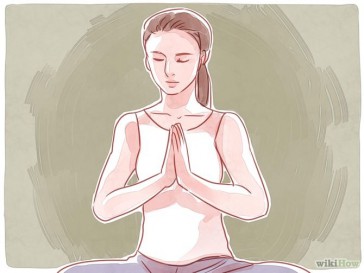How to Be a Mystic, In three parts:
1 Thinking Mystically, 2 Building a Mystical Foundation, 3 Going Deeper
Being a mystic is a lifelong process of learning and deep contemplation which must not be taken as a game or very lightly. Identifying the spiritual practice or tradition which speaks to you and starts answering the questions you’re interested in is step one. But then the real work starts. If you want to get a personal connection to the spiritual world as a mystical thinker, you can learn to lay a foundation for contemplation, prayer, and meditation, as well as how to deepen that practice into a serious understanding. Are you up to the challenge?
Part 1 of 3: Thinking Mystically

1 Feel the presence of a guiding hand. Whether you think of yourself as a deeply spiritual person or not, a mystic is one who seeks to find order in the chaos and collect evidence of that order. If you’re the kind of person who sees every strange coincidence, every elegant metaphor, or every pretty rainbow as a sign of something greater, you might begin to feel the presence of a guiding hand in which you place your trust.[1] Religious mystics place their trust in a higher power, a powerful being that creates and controls the world and the people in it. Sometimes, as in the case of Zen Buddhism, religious mystics will also place their trust in a practice, that asceticism and meditation are the truest way to understand the world. Mystics aren’t always religious, though they often are. The writing of quantum physicists and Jungian psychologists often borders on the mystical, the deeper it gets. Whatever system, being, or practice you’ve found in which to place your trust, place it there.

2 Look for the interconnectedness of things around you. Seek to find order and balance in the world, rather than emphasizing differences and disparities. Look for things you have in common with your enemies.[2] Regardless of your spiritual or religious leanings, it’s good to read and study a wide variety of mystical writings, across disciplines and dogmas. Christian writer Thomas Merton spent considerable time studying Zen Buddhism

3 Emphasize experience. What is a mystic? What differentiates a Christian mystic from a regular Christian, or a Buddhist mystic from a regular Buddhist? Across practices, disciplines, and cultures, mystics have one thing in common: a deep personal and spiritual connection to their belief system. To the mystic, a personal experience of spirituality is always more powerful and more important than book-learning or hearsay. Simply going to church isn’t enough for the mystic. Avoid the showy materialist trappings of some religions. You don’t need an expensive rock garden, koi pond, and meditation pad to be a Buddhist mystic. You don’t need a 13th century crucifix to be a Christian.

4 Be present. Mystics need to center themselves and be fully present at all times. A mystic isn’t distracted by electronic devices, stresses, or complex schedules for the day. Instead, the mystic should be focused completely on doing one thing and one thing only. When you’re eating lunch, just eat lunch. Focus entirely on nourishing your body, slowing down, enjoying what you eat. When you’re reading the newspaper, just focus on learning, reading the words, and understanding the concepts. Put yourself completely into each task. This can be surprisingly difficult, and it won’t happen right away. Buzzing text alerts and constant 21st century noise can make it hard to slow down and focus. Try to simplify your life as much as possible. Start small. Put your phone away, except when you actively need it to make a call or send a message.

5 Question everything. Mystics want personal connections to the spiritual world and the self, not hearsay. Received wisdom and platitudes are made to be questioned by mystics. If you want to develop your mystical connections to the world, both seen and unseen, start asking the big questions.[3] Whatever you religious or spiritual leanings, learn to embrace the big questions: Why are we here? What does it mean to live a good life? Who am I? What happens when we die? What does death mean to me?

6 Trust your intuition. Not only is it important to ask the big questions, but to trust that your instincts will lead you to the answers that you seek. Trust in yourself. Develop your intuition and your self-reliance. Eliminate your doubts and trust that you’ll have the faith to discover what you’re looking for.[4]
Part 2 of 3: Building a Mystical Foundation

7 Read the writings of the mystics in your tradition. Studying mystical writings and tomes is an essential way to learn about the lives of the mystics. Each tradition will have a wide variety of different mystics and different dogmas, and it’s important to get some sense of the scope of different writings. Everything starts to seem interconnected and becomes more alike than different: Thomas Merton’s No Man is an Island, St. Augustine’s Confessions of St. Augustine, The Cloud of Unknowing, written anonymously, Julian of Norwich’s Revelation of Divine Love, DT Suzuki’s An Introduction to Zen Buddhism, The Nasruddin Stories from the Sufic tradition

8 Identify the central tenants of your practice. Mystical practice is a combination of self-imposed meditation and contemplation and the specific guidelines of your religion or other practice. Each religious life will be different, because each religious person is different. Deciding what’s most important to you and your practice is a decision that only one person can make. You.[5] For some mystical Christians, living life as close to the way Christ lived is the most important aspect of practicing. For others, spreading the gospel is essential. Both ways of thinking can lead to mysticism and deep appreciations of the spiritual world.

9 Make your spiritual practice your main priority. Mystics aren’t part-time. Whatever your deep connection to religion and the big questions, it needs to be your biggest priority in life. Not your job, your family, or your hobbies. Your connection with the cosmos needs to be your biggest commitment.[6] For many people, being a mystic is an entirely solitary life. Most mystics are monastic for a reason. If you want to be a mystic, it’s hard to go out on Saturday night and have fun. Are you up to the challenge to commit?

10 Embrace mystery. Part of Zen meditation revolves around letting go of these big concerns and embracing the void. For the mystic, that void should be your living room. Trusting in your instincts and diving into the biggest questions has a tendency to lead to even more questions than answers. It could either be frustrating or liberating to realize that you might never know what will happen after you die, or whether or not you’re really “right” about your way of interpreting the world.
Part 3 of 3: Going Deeper

11 Develop a deep belief system with prayer and contemplation. Whatever religion or belief system that you align you with, or even if you don’t align yourself with any organized religion at all, you need to carve out time in your schedule for deep contemplation and meditative training. Pray, meditate, and contemplate constantly. To start praying, focus less on asking specific yes-no types of questions and more on focusing on feeling. How does it feel to get in touch with the higher power in which you believe? How does talking with your god affect your soul? For some monastics, time needs to be divided evenly between reading the great texts, meditating, and experiencing the world. As a general rule of thumb, don’t spend more time praying than you spend studying the religious texts you study, and vice versa.

12 Develop your awareness through meditation. There’s no specific goal or outcome of a meditative practice. You don’t come out the other side of a meditation sitting feeling as if you’ve learned something, necessarily, or as if you’ve solved the big problems that you seek. Instead, focus on stilling yourself and increasing your awareness, then taking that into the world.[7] To start meditating, learn to still your thoughts and watch them float through your mind without identifying them actively. Just sit, focus on your breathing, and fix your gaze on the void. Try to hold onto your meditation-mind for as long as possible throughout the day. Notice the little things. Slow down.

13 Abandon needless beliefs. A popular Zen saying compares Zen to a boat. You use when you need to cross the river, but you don’t take it with you. Learn to leave your Zen on the shore when it becomes unnecessary. Religion, meditative practices, and other aspects of your mystical experience should serve your understanding of the world, not burden it.

14 Surround yourself with mystical people. It’s important to spend time with like-minded believers who take their mystical practice seriously. Learn by observing and having complicated conversations with people from your church, organization, or other religious groups. Bounce ideas and interpretations off each other. Learn as much as you can. In some traditions, finding a teacher, mentor, or guru is an essential part of practicing your own brand of mysticism and developing as a mystical thinker. If you’re ready to pledge yourself to a serious practice, consider finding a personal teacher.
Source: How to Be a Mystic: 14 Steps (with Pictures) – wikiHow